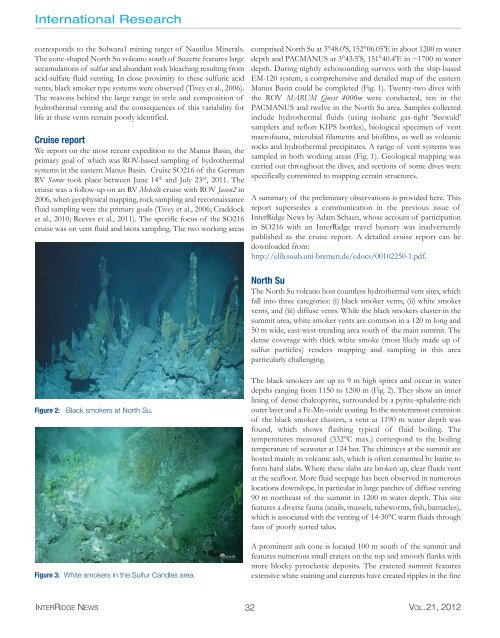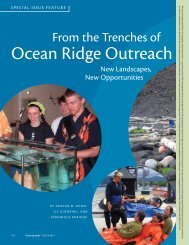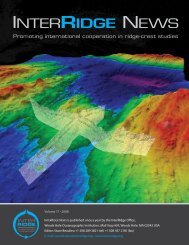Full version, low resolution, 7.5MB - InterRidge
Full version, low resolution, 7.5MB - InterRidge
Full version, low resolution, 7.5MB - InterRidge
Create successful ePaper yourself
Turn your PDF publications into a flip-book with our unique Google optimized e-Paper software.
International Research<br />
corresponds to the Solwara1 mining target of Nautilus Minerals.<br />
The cone-shaped North Su volcano south of Suzette features large<br />
accumulations of sulfur and abundant rock bleaching resulting from<br />
acid-sulfate fluid venting. In close proximity to these sulfuric acid<br />
vents, black smoker type systems were observed (Tivey et al., 2006).<br />
The reasons behind the large range in style and composition of<br />
hydrothermal venting and the consequences of this variability for<br />
life at these vents remain poorly identified.<br />
Cruise report<br />
We report on the most recent expedition to the Manus Basin, the<br />
primary goal of which was ROV-based sampling of hydrothermal<br />
systems in the eastern Manus Basin. Cruise SO216 of the German<br />
RV Sonne took place between June 14 th and July 23 rd , 2011. The<br />
cruise was a fol<strong>low</strong>-up on an RV Melville cruise with ROV Jason2 in<br />
2006, when geophysical mapping, rock sampling and reconnaissance<br />
fluid sampling were the primary goals (Tivey et al., 2006; Craddock<br />
et al., 2010; Reeves et al., 2011). The specific focus of the SO216<br />
cruise was on vent fluid and biota sampling. The two working areas<br />
comprised North Su at 3°48.0'S, 152°06.05'E in about 1200 m water<br />
depth and PACMANUS at 3°43.5'S, 151°40.4'E in ~1700 m water<br />
depth. During nightly echosounding surveys with the ship-based<br />
EM-120 system, a comprehensive and detailed map of the eastern<br />
Manus Basin could be completed (Fig. 1). Twenty-two dives with<br />
the ROV MARUM Quest 4000m were conducted, ten in the<br />
PACMANUS and twelve in the North Su area. Samples collected<br />
include hydrothermal fluids (using isobaric gas-tight 'Seewald'<br />
samplers and teflon KIPS bottles), biological specimen of vent<br />
macrofauna, microbial filaments and biofilms, as well as volcanic<br />
rocks and hydrothermal precipitates. A range of vent systems was<br />
sampled in both working areas (Fig. 1). Geological mapping was<br />
carried out throughout the dives, and sections of some dives were<br />
specifically committed to mapping certain structures.<br />
A summary of the preliminary observations is provided here. This<br />
report supersedes a communication in the previous issue of<br />
<strong>InterRidge</strong> News by Adam Schaen, whose account of participation<br />
in SO216 with an <strong>InterRidge</strong> travel bursary was inadvertently<br />
published as the cruise report. A detailed cruise report can be<br />
downloaded from:<br />
http://elib.suub.uni-bremen.de/edocs/00102250-1.pdf.<br />
Figure 2:<br />
Black smokers at North Su.<br />
North Su<br />
The North Su volcano host countless hydrothermal vent sites, which<br />
fall into three categories: (i) black smoker vents, (ii) white smoker<br />
vents, and (iii) diffuse vents. While the black smokers cluster in the<br />
summit area, white smoker vents are common in a 120 m long and<br />
50 m wide, east-west-trending area south of the main summit. The<br />
dense coverage with thick white smoke (most likely made up of<br />
sulfur particles) renders mapping and sampling in this area<br />
particularly challenging.<br />
The black smokers are up to 9 m high spires and occur in water<br />
depths ranging from 1150 to 1200 m (Fig. 2). They show an inner<br />
lining of dense chalcopyrite, surrounded by a pyrite-sphalerite-rich<br />
outer layer and a Fe-Mn-oxide coating. In the westernmost extension<br />
of the black smoker clusters, a vent at 1190 m water depth was<br />
found, which shows flashing typical of fluid boiling. The<br />
temperatures measured (332°C max.) correspond to the boiling<br />
temperature of seawater at 124 bar. The chimneys at the summit are<br />
hosted mainly in volcanic ash, which is often cemented by barite to<br />
form hard slabs. Where these slabs are broken up, clear fluids vent<br />
at the seafloor. More fluid seepage has been observed in numerous<br />
locations downslope, in particular in large patches of diffuse venting<br />
90 m northeast of the summit in 1200 m water depth. This site<br />
features a diverse fauna (snails, mussels, tubeworms, fish, barnacles),<br />
which is associated with the venting of 14-30°C warm fluids through<br />
fans of poorly sorted talus.<br />
Figure 3: White smokers in the Sulfur Candles area.<br />
A prominent ash cone is located 100 m south of the summit and<br />
features numerous small craters on the top and smooth flanks with<br />
more blocky pyroclastic deposits. The cratered summit features<br />
extensive white staining and currents have created ripples in the fine<br />
INTERRIDGE NEWS 32 VOL.21, 2012
















